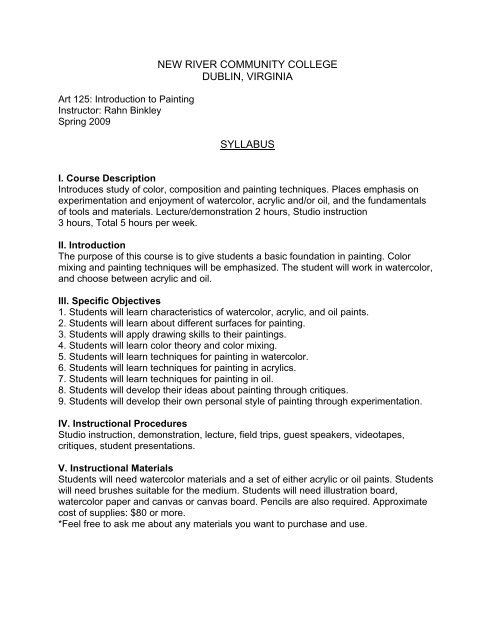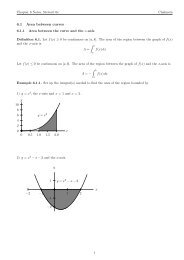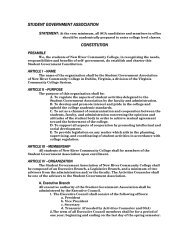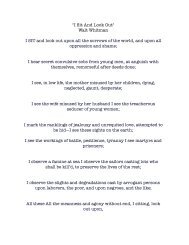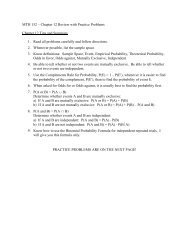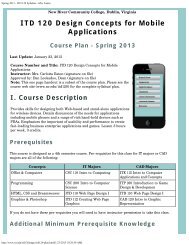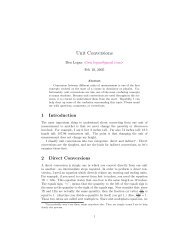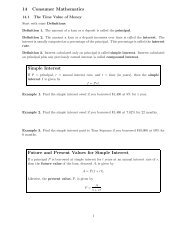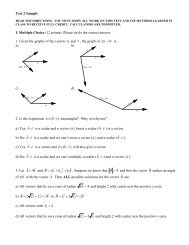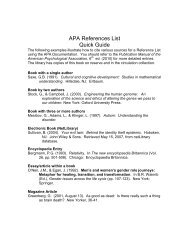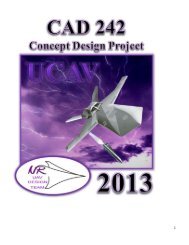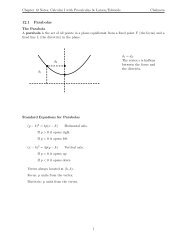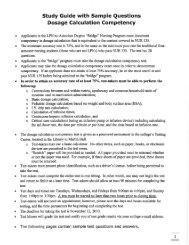NEW RIVER COMMUNITY COLLEGE DUBLIN, VIRGINIA SYLLABUS
NEW RIVER COMMUNITY COLLEGE DUBLIN, VIRGINIA SYLLABUS
NEW RIVER COMMUNITY COLLEGE DUBLIN, VIRGINIA SYLLABUS
Create successful ePaper yourself
Turn your PDF publications into a flip-book with our unique Google optimized e-Paper software.
Art 125: Introduction to Painting<br />
Instructor: Rahn Binkley<br />
Spring 2009<br />
<strong>NEW</strong> <strong>RIVER</strong> <strong>COMMUNITY</strong> <strong>COLLEGE</strong><br />
<strong>DUBLIN</strong>, <strong>VIRGINIA</strong><br />
<strong>SYLLABUS</strong><br />
I. Course Description<br />
Introduces study of color, composition and painting techniques. Places emphasis on<br />
experimentation and enjoyment of watercolor, acrylic and/or oil, and the fundamentals<br />
of tools and materials. Lecture/demonstration 2 hours, Studio instruction<br />
3 hours, Total 5 hours per week.<br />
II. Introduction<br />
The purpose of this course is to give students a basic foundation in painting. Color<br />
mixing and painting techniques will be emphasized. The student will work in watercolor,<br />
and choose between acrylic and oil.<br />
III. Specific Objectives<br />
1. Students will learn characteristics of watercolor, acrylic, and oil paints.<br />
2. Students will learn about different surfaces for painting.<br />
3. Students will apply drawing skills to their paintings.<br />
4. Students will learn color theory and color mixing.<br />
5. Students will learn techniques for painting in watercolor.<br />
6. Students will learn techniques for painting in acrylics.<br />
7. Students will learn techniques for painting in oil.<br />
8. Students will develop their ideas about painting through critiques.<br />
9. Students will develop their own personal style of painting through experimentation.<br />
IV. Instructional Procedures<br />
Studio instruction, demonstration, lecture, field trips, guest speakers, videotapes,<br />
critiques, student presentations.<br />
V. Instructional Materials<br />
Students will need watercolor materials and a set of either acrylic or oil paints. Students<br />
will need brushes suitable for the medium. Students will need illustration board,<br />
watercolor paper and canvas or canvas board. Pencils are also required. Approximate<br />
cost of supplies: $80 or more.<br />
*Feel free to ask me about any materials you want to purchase and use.
General Guidelines for Paint Supplies (watercolor, acrylic, oil):<br />
Sets with 10 colors in acrylic and oil are adequate for this class (You may also choose<br />
to supplement your set with more colors.), but for watercolor, I recommend buying<br />
separate watercolor tubes. (See below for suggested colors.)<br />
The best brands of paint are: Grumbacher, Windsor and Newton (Cotman), Liquitex,<br />
and Shiva Oils.<br />
All paints need brushes. Be sure to have fine, medium, and broad brushes for<br />
watercolor, acrylic or oil. Make sure you get the right kind of brush for the type of paint<br />
you are using.<br />
Don't buy any kiddie art supplies.<br />
If you want to keep your clothes clean, bring an apron or some kind of smock.<br />
Watercolor Supplies:<br />
Suggested colors: cadmium red, cadmium yellow light, alizarin crimson, ultramarine<br />
blue, yellow ochre, viridian hue, burnt sienna, burnt umber,- and if you can afford it:<br />
lemon yellow, thalo blue, indian red, permanent rose, indigo.<br />
Paper: Strathmore 400 Watercolor block or Arches are good brands. (11x15", 13x17",<br />
or 15x20")<br />
A white plastic dish makes a fine palette, water container.<br />
All supplies are suggestions. You may vary brands and colors.<br />
Oil Supplies:<br />
CAUTION! Oil paint must be thinned with a solvent. Many people are allergic to<br />
turpentine and paint thinner. Special odorless paint thinner must be used in class.<br />
For brush cleaning: a 15oz metal can or slightly larger, or you may purchase a brush<br />
cleaning screened container.<br />
Suggested Colors: Cadmium red, cadmium yellow light, alizarin crimson, thalo blue,<br />
Ultramarine (or cobalt) blue, chromium oxide green, green earth, burnt sienna, raw<br />
sienna, raw umber, titanium white (large tube)<br />
Canvas: pre-stretched canvas, minimum 9x12", maximum 20x24".<br />
Palettes for oil paint: disposable paper palette, covered palette in class, plexiglass,<br />
hand-held palette.<br />
Cotton rags: old t-shirts or jeans are fine.<br />
Acrylic Supplies:<br />
Canvas and Colors: same as for oil.<br />
Palettes for acrylic: a white plastic plate, covered palette, paper, etc.<br />
Brush cleaning: Water container, paper towel.<br />
No text book is required.
VI. Course Content<br />
1. Painting materials: watercolor, acrylic, oil<br />
2. Painting surfaces<br />
3. Drawing techniques for developing paintings<br />
4. Color theory and color mixing<br />
5. Color, line, texture, form ( 3-dimensional), space, value<br />
6. Composition and design: proportion, rhythmic movement, contrast, balance,<br />
emphasis, unity<br />
7. Techniques for watercolor painting.<br />
8. Techniques for acrylic painting.<br />
9. Techniques for oil painting<br />
10. Subjects covered: still life, landscape, portrait, abstract.<br />
11. Framing and matting<br />
12. Student Presentation and critique.<br />
VII. Evaluation<br />
Grading in a visual art course is subjective. Students should feel free to discuss assigned<br />
grades at any time. Grading is based on demonstrated skill, mastery of technique and<br />
completion of assignments according to instructions. Time, effort, improvement shown,<br />
and active participation in critiques are also considered. Attendance is considered in<br />
assigning grades.<br />
VIII. Attendance<br />
Students who miss more than 6 classes will receive a letter grade lower than what was<br />
earned in the course. It is very important to attend class on a regular basis. Students<br />
should let the instructor know if several classes are to be missed so make up work can<br />
be assigned. In case of inclement weather which causes the school to close, students<br />
will check for assignments on the online Blackboard.<br />
IX. Withdrawal Policy<br />
Student Initiated Withdrawal Policy<br />
A student may withdraw from a class without academic penalty during the first sixty<br />
percent (60%) of a session. For purposes of enrollment reporting, the following<br />
procedures apply:<br />
a. If a student withdraws from a class prior to the termination of the add/drop period for<br />
the session, the student is removed from the class roll and no grade will be awarded.<br />
b. After the add/drop period, but prior to completion of sixty percent (60%) of a session,<br />
a student who withdraws or is withdrawn from a course will be assigned a grade of “W”<br />
c. After that time, if a student withdraws from a class, a grade of "F" will be assigned.<br />
Exceptions to this policy may be made under mitigating circumstances; such<br />
circumstances must be documented and a copy of the documentation placed in the<br />
student's academic file.<br />
A grade of withdrawal implies that the student was making satisfactory progress in
the class at the time of withdrawal, or that the withdrawal was officially made before<br />
the deadline date published in the college calendar, or that the student was<br />
administratively transferred to a different program.<br />
Instructor Initiated Withdrawal Policy<br />
A student who adds a class or registers after the first day of class is counted absent from<br />
all class meetings missed. Each instructor is responsible for keeping a record of student<br />
attendance in each class.<br />
Students who have not attended class by the last day to drop class and receive refund<br />
must be deleted by the instructor during the following week. No refund will be applicable.<br />
When a student's absences equal twice the number of weekly meetings of a class, the<br />
student may be dropped for unsatisfactory attendance in the class by the instructor.<br />
When an instructor determines that absences constitute unsatisfactory attendance, a<br />
Faculty Withdrawal Form should be completed and submitted to the Admissions and<br />
Records Office.<br />
The last date of attendance must be documented. A grade of "W" will be recorded during<br />
the first sixty percent (60%) of a course. Students withdrawn after the sixty percent<br />
(60%) period will receive a grade of "F" except under mitigating circumstances, which<br />
must be documented. A copy of this documentation must be placed in the student's<br />
academic file.<br />
The student will be notified of the withdrawal by the Admissions and Records Office. An<br />
appeal for reinstatement into the class may be approved only by the instructor.<br />
X. Cheating<br />
Turning in someone else work will result in an F on the assignment. All work should be<br />
completed in the semester the student is taking this class. Old work done in high school<br />
or in other art classes is not acceptable.<br />
XI. Fire<br />
In case of fire, exit the art room by the front door. Turn left and exit Martin Hall at the<br />
main entrance.<br />
If you have any questions, call me at (540) 921-0409.


